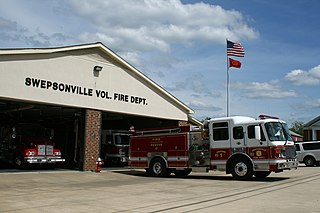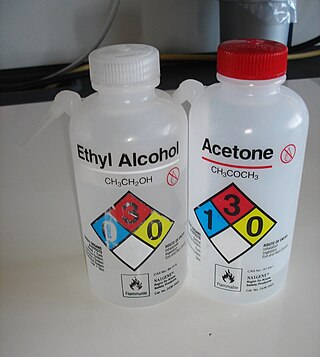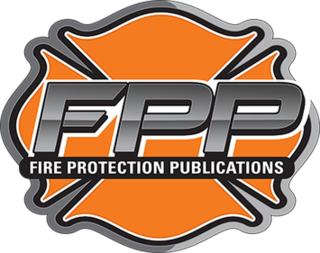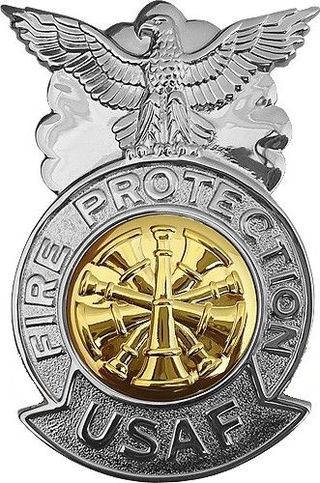
A firefighter is a first responder and rescuer extensively trained in firefighting, primarily to extinguish hazardous fires that threaten life, property, and the environment as well as to rescue people and in some cases or jurisdictions also animals from dangerous situations. Male firefighters are sometimes referred to as firemen.

A volunteer fire department (VFD) is a fire department of volunteers who perform fire suppression and other related emergency services for a local jurisdiction. Volunteer and retained (on-call) firefighters are expected to be on call to respond to emergency calls for long periods of time, and are summoned to the fire station when their services are needed. They are also expected to attend other non-emergency duties as well.
In firefighting, the policy of two-in, two-out refers to United States Occupational Safety and Health Administration (OSHA) policy 29 CFR 1910.134(g)(4)(i). The respiratory protection standard requires that workers engaged in fighting interior structural fires work in a buddy system; at least two workers must enter the building together, so that they can monitor each other's whereabouts as well as the work environment. There must also be at least two standby personnel outside the fire area prepared to rescue the inside firefighters should the need arise. One of these outside firefighters must actively monitor the status of the inside fighters but the second outside firefighter may perform a variety of other duties, such as pump operations, incident commander or outside hose line operation. There are no provisions in the standard to waive the requirements for either the "two-inside firefighters" or the "two-outside firefighters", although the circumstances under which this provision applies are more limited than generally understood.

Fire safety is the set of practices intended to reduce the destruction caused by fire. Fire safety measures include those that are intended to prevent the ignition of an uncontrolled fire and those that are used to limit the development and effects of a fire after it starts.

"NFPA 704: Standard System for the Identification of the Hazards of Materials for Emergency Response" is a standard maintained by the U.S.-based National Fire Protection Association. First "tentatively adopted as a guide" in 1960, and revised several times since then, it defines the colloquial "Safety Square" or "Fire Diamond" which is used by emergency personnel to quickly and easily identify the risks posed by hazardous materials. This helps determine what, if any, special equipment should be used, procedures followed, or precautions taken during the initial stages of an emergency response. It is an internationally accepted safety standard, and is crucial while transporting chemicals.

A water tender is a type of firefighting apparatus that specialises in the transport of water from a water source to a fire scene. Water tenders are capable of drafting water from a stream, lake or hydrant.

Dangerous goods, abbreviated DG, are substances that when transported are a risk to health, safety, property or the environment. Certain dangerous goods that pose risks even when not being transported are known as hazardous materials. An example for dangerous goods is hazardous waste which is waste that has substantial or potential threats to public health or the environment.
Firefighting jargon includes a diverse lexicon of both common and idiosyncratic terms. One problem that exists in trying to create a list such as this is that much of the terminology used by a particular department is specifically defined in their particular standing operating procedures, such that two departments may have completely different terms for the same thing. For example, depending on whom one asks, a safety team may be referred to as a standby, a RIT or RIG or RIC, or a FAST. Furthermore, a department may change a definition within its SOP, such that one year it may be RIT, and the next RIG or RIC.
A firefighter assist and search team (FAST), also known as a rapid intervention team/rapid intervention crew/rapid intervention dispatch (RIT/RIC/RID), is a team of two or more firefighters dedicated solely to the search and rescue of other firefighters in distress. Firefighter Assist and Search Team personnel shall have no other operational assignment during any incident. Multiple alarm fires may require multiple FAST/RIC teams.

A rescue vehicle is a specialised vehicle used in technical rescue. It is designed to transport and provide the specialized equipment necessary for technical rescue. They carry an array of special equipment such as the jaws of life, wooden cribbing, generators, winches, hi-lift jacks, cranes, cutting torches, circular saws and other forms of heavy equipment unavailable on standard trucks. This capability differentiates them from traditional pumper trucks or ladder trucks designed primarily to carry firefighters and their entry gear as well as on-board water tanks, hoses and equipment for fire extinguishing and light rescue. Most rescue vehicles lack on-board water tanks and pumping gear, owing to their specialized role. A rescue vehicle is typically operated by a rescue squad, but in some areas it may be integrated with emergency medical services or fire departments.

A wildland fire engine is a fire engine specifically designed to assist in fighting wildfires by transporting firefighters to the scene and providing them with access to the fire, along with water or other equipment. Most commonly used by the United States Forest Service, there are multiple types of wildfire apparatus which are used in different scenarios. According to the National Fire Protection Association, if the apparatus will be used primarily for outdoor and wildland responses, then it is to be considered a wildland fire apparatus and must conform to NFPA 1906.

Bunker gear is the personal protective equipment (PPE) used by firefighters. The terms are derived from the fact that the trousers and boots are traditionally kept by the firefighter's bunk at the fire station to be readily available for use.

Fire Protection Publications (FPP) is a department of the College of Engineering, Architecture, and Technology (CEAT) a division within Oklahoma State University (OSU), in Stillwater, Oklahoma. FPP is the world's leading publisher of training materials for the fire and emergency services. FPP also serves as the headquarters for the International Fire Service Training Association (IFSTA). FPP and IFSTA have worked together to bring the fire service quality training materials for more than 85 years.
International Fire Service Training Association is an association of fire service personnel who are dedicated to upgrading fire fighting and other emergency response techniques and safety through training. The mission of IFSTA is to identify areas of need for training materials and to foster the development and validation of training materials for the fire service and related areas. IFSTA publishes such manuals as the Essentials of Fire Fighting, Fire and Emergency Services Instructor, Fire and Emergency Services Company Officer, Chief Officer, Building Construction Related to the Fire Service, Hazardous Materials for First Responders, and many others, in both print and eBook formats. Other training materials produced by IFSTA include curricula, study guides, videos, apps, and the ResourceOne course management system.

Firefighting in the United States dates back to the earliest European colonies in the Americas. Early firefighters were simply community members who would respond to neighborhood fires with buckets. The first dedicated volunteer fire brigade was established in 1736 in Philadelphia. These volunteer companies were often paid by insurance companies in return for protecting their clients.
Operations Plus WMD is a training level in dealing with hazardous materials.

The School of Fire Protection and Safety at Oklahoma State University in Stillwater, Oklahoma has been home to one of the few fire protection programs in North America since its creation in 1937.

A hazardous material (hazmat) apparatus is a vehicle used by emergency services to respond to calls involving potentially hazardous materials. These vehicles are customized to fit the needs of the agency responsible for the apparatus, which may be a rescue squad, fire department, emergency medical services, law enforcement agency, or military.

The United States Air Force Fire Protection career specialty is the military's premiere specialty in fire protection. Much like their civilian counterparts, these military firefighters protect people, property, and the environment from fires and disasters. They provide firefighting, specialized rescue, HazMat responses, as well as provide fire prevention and response to weapons of mass destruction. Though every branch has its own fire protection career specialties, they all must graduate from the Air Force's 13.5 week fire academy in San Angelo, Texas before being awarded their Firefighter certification.
A Special operations firefighter, also known as Fire Service Special Operations, is a specialist firefighter who has been specially trained to execute tasks other than standard firefighting operations. The National Fire Protection Association's Standard for the Organization and Deployment of Fire Suppression Operations, Emergency Medical Operations, and Special Operations to the Public by Career Fire Departments defines special operations as "Those emergency incidents to which the fire department responds that require specific and advanced training and specialized tools and equipment". The NFPA 1710 further defined special operations as "Special operations include water rescue, extrication, hazardous materials, confined space entry, highangle rescue, aircraft rescue and fire fighting, and other operations requiring specialized training".














